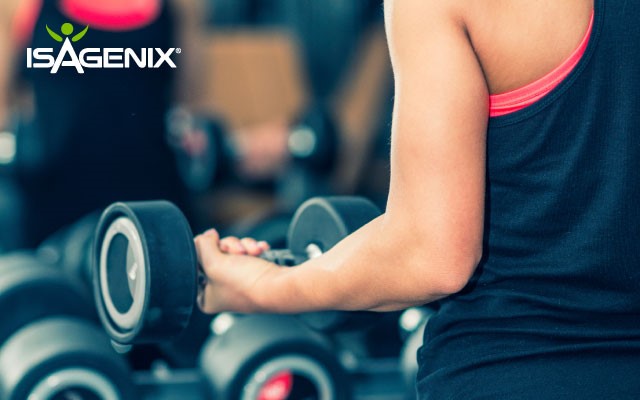Keeping muscle during weight loss should be just as an important a goal as burning fat.
However, people focusing on diet alone can lose anywhere from 20-30 percent of their weight loss from lean body mass, most of which is from muscle tissue (1).
While the scale may show the pounds dropping, this isn’t good news for body composition. Beyond looking good in the mirror, muscle quality and quantity is a major determinant of metabolic rate, exercise capacity, and healthy aging (2).
For the average person, muscle tissue makes up about around 40 to 50 percent of body mass (3). Yet muscle undergoes rapid turnover, meaning it’s constantly being built up or broken down. The rate of turnover depends on two very important variables which all of us have control over: exercise and nutrition.
Resistance exercise like lifting weights helps prevent the loss of muscle during an energy deficit by stimulating the cellular machinery in the cell that make proteins for muscle (3, 4). This process is muscle protein synthesis, or MPS. However, simply stimulating the machine to build muscle protein isn’t enough; there needs to be building material.
This is where dietary protein comes in – while it’s well known that consuming protein in combination with resistance training can increase lean body mass, it can also preserve muscle during weight loss (3). In fact, when in negative energy balance, the anabolic response to protein is enhanced (5). This increase in efficiency is an adaptive mechanism meant to preserve muscle during starvation (6). The body has also an increased need for protein in states of negative energy balance.
Whereas a modest reduction in energy can increase protein requirements, it’s even further increased with resistance exercise. But when significant weight loss occurs and energy is cut too drastically, muscle tends to be lost in much greater amounts (7). Coupling resistance training with increased protein intake during fat loss improves body composition, aids metabolism, and prevents decreases in performance.
Taking this a step further, dividing up protein intake equally over the day in the format of protein pacing can help the body absorb the protein more effectively. The research on protein pacing by nutrition and exercise researcher Paul Arciero clearly showed that performance measures improved with increased protein intake in both males and females (8, 9).
The bottom line is that if fat loss is your goal, include some form of resistance training like weightlifting or high-intensity interval training. Aim for a protein intake of 1.5 to 2.0 grams per kilogram per day divided over several meals containing at least 20 grams of high quality protein (10).
Lose the right type of weight during weight loss, which is fat, not muscle.
References
- Weinheimer EM, Sands LP, Campbell WW. A systematic review of the separate and combined effects of energy restriction and exercise on fat-free mass in middle-aged and older adults: implications for sarcopenic obesity. Nutr Rev. 2010 Jul;68(7):375-88.
- Karagounis LG, Hawley JA. Skeletal muscle: increasing the size of the locomotor cell. Int J Biochem Cell Biol. 2010 Sep;42(9):1376-9.
- Pasiakos SM, Cao JJ, Margolis LM et al. Effects of high-protein diets on fat-free mass and muscle protein synthesis following weight loss: a randomized controlled trial. FASEB J. 2013 Sep;27(9):3837-47.
- Areta JL, Burke LM, Camera DM et al. Reduced resting skeletal muscle protein synthesis is rescued by resistance exercise and protein ingestion following short-term energy deficit. Am J Physiol Endocrinol Metab. 2014 Apr 15;306(8): E989-97.
- Saudek CD, Felig, P. The metabolic events of starvation. Am J Med. 1976 Jan;60(1):117-26.
- Fielding RA, Parkington J. What are the dietary protein requirements of physically active individuals? New evidence on the effects of exercise on protein utilization during post-exercise recovery. Nutr Clin Care. 2002 Jul-Aug;5(4):191-6.
- Chaston TB, Dixon JB, O’Brien PE. Changes in fat-free mass during significant weight loss: a systematic review. Int J Obes. 2007 May;31(5):743-50.
- Arciero PJ, Ives SJ, Norton C et al. Protein-Pacing and Multi-Component Exercise Training Improves Physical Performance Outcomes in Exercise-Trained Women: The PRISE 3 Study. Nutrients. 2016 Jun 1;8(6).
- Ives SJ, Norton C, Miller V et al. Multi-modal exercise training and protein-pacing enhances physical performance adaptations independent of growth hormone and BDNF but may be dependent on IGF-1 in exercise-trained men. Growth Horm IGF Res. 2017 Feb; 32:60-70.
- Jäger R, Kerksick CM, Campbell BI et al. International Society of Sports Nutrition Position Stand: protein and exercise. J Int Soc Sports Nutr. 2017 Jun 20; 14:20.





